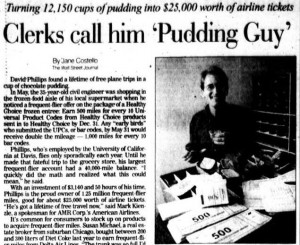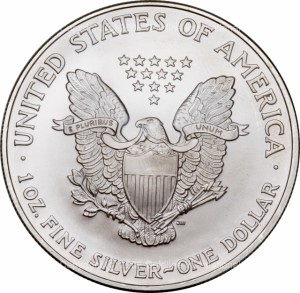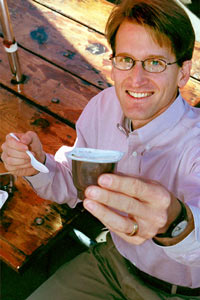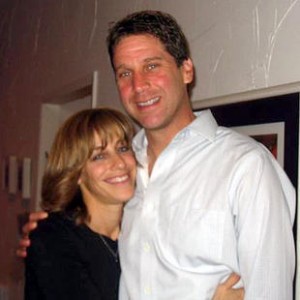Travel Hacker Hall of Fame
1st Inductee – David Phillips, AKA The Pudding Guy
Perhaps the best known “travel hacker” is David Phillips — commonly referred to as the Pudding Guy. Phillips’ tale of collecting frequent flyer miles via a Healthy Choice promotion has become the stuff of legends among the frequent flyer community and beyond — even having his scheme immortalized into the storyline of the motion picture film Punch-Drunk Love.
In May of 1999, while shopping for frozen foods in his local grocer, Phillips spotted a promotion run by Healthy Choice whereby consumers who purchased ten Healthy Choice products were offered 1000 frequent flyer miles from the airline of their choosing. At $2 per meal, Phillips quickly did the math and realized this was a decent promotion and would help in his quest to take his family on a vacation to Europe. While the frozen meal offered a good opportunity, he realized just a few aisles over, at 90 cents per unit, the Healthy Choice canned soups he found offered an even better payout. He quickly filled his cart up with the soups and drove to the closest grocery outlet, a warehouse-style discount store ala Costco, hoping to further capitalize on the newfound opportunity.
There he found the holy grail of frequent flyer points.
At the grocery outlet, he found that Healthy Choice had a line of pudding snacks that were being sold as single serving units at only 25 cents! He bought the whole lot. But he didn’t stop there; he tracked down every warehouse grocery outlet in the Central Valley and proceeded to clear out all their racks too – ten grocery outlets in total. In all, he purchased 12,150 individual pudding cups with a potential for over a million miles!
 There was only one caveat. After going through the arduous process of removing the UPC seal on his first batch of pudding cups, which had to be mailed in as proof of purchase, he soon realized that even with the help of his whole family, he wouldn’t meet the deadline of June 1st at the pace they were moving. This is where he had perhaps the most ingenious idea in the scheme; he enlisted the help of the local Salvation Army with the promise that he’d donate the pudding to their soup kitchen in exchange for the help from its employees to remove the UPC codes – a win-win solution! With the help of the Salvation Army, he was able to meet the deadline and amass the phenomenal sum of 1,253,000 miles! In all, he got the equivalent of 31 round trip tickets to Europe for “a little over $3000.” And to top it off, he got a tax write-off of $815 for his donation.
There was only one caveat. After going through the arduous process of removing the UPC seal on his first batch of pudding cups, which had to be mailed in as proof of purchase, he soon realized that even with the help of his whole family, he wouldn’t meet the deadline of June 1st at the pace they were moving. This is where he had perhaps the most ingenious idea in the scheme; he enlisted the help of the local Salvation Army with the promise that he’d donate the pudding to their soup kitchen in exchange for the help from its employees to remove the UPC codes – a win-win solution! With the help of the Salvation Army, he was able to meet the deadline and amass the phenomenal sum of 1,253,000 miles! In all, he got the equivalent of 31 round trip tickets to Europe for “a little over $3000.” And to top it off, he got a tax write-off of $815 for his donation.
Minting Miles – The Holy Grail of Manufactured Spending
 In mid-2008 bank managers across the country began to notice an odd trend: a small group of customers were literally wheeling in barrels of newly minted one-dollar coins (often still in their original packaging from the US mint) and depositing them into their bank accounts. Even odder, these otherwise normal bank patrons would be seen doing this on multiple occasions with total deposits sometimes exceeding hundreds of thousands of dollars. Who were these odd folks and where were they getting all these one dollar coins? Turns out these were some savvy “miles junkies” who were taking advantage of recent government legislation that allowed them to acquire large sums of frequent flyer miles for free in one of the most aggressive manufactured spending schemes documented.
In mid-2008 bank managers across the country began to notice an odd trend: a small group of customers were literally wheeling in barrels of newly minted one-dollar coins (often still in their original packaging from the US mint) and depositing them into their bank accounts. Even odder, these otherwise normal bank patrons would be seen doing this on multiple occasions with total deposits sometimes exceeding hundreds of thousands of dollars. Who were these odd folks and where were they getting all these one dollar coins? Turns out these were some savvy “miles junkies” who were taking advantage of recent government legislation that allowed them to acquire large sums of frequent flyer miles for free in one of the most aggressive manufactured spending schemes documented.
The root of this scheme goes back to the Presidential One Dollar Coin Act of 2005, whereby an act of congress required the US mint to produce and put into circulation millions of newly minted one dollar coins. Part of the reasoning behind the congressional act was that coins have a longer circulation life than dollar bills, and therefore, should prove to be a better, more economical alternative. However, the idea of carrying clunky pocketfuls of coins instead of dollar bills never caught on with the general public, and the mint was left with a surplus of over $1B in newly minted coins.
With a surplus of dollar coins now stockpiling in their facilities, the US mint decided it needed to do come up with a plan to encourage their circulation.
Enter the “direct ship” program. As part of their plan to encourage the circulation of dollar coins, the mint decided to fulfill orders directly to the American public free of shipping costs. Whereas it would cost normally cost $3 to ship a box of 250 coins through the mail, the mint was offering free shipping to those who ordered the coins. You can imagine where the story goes from here. The US Mint opened the door to perhaps the holy grail of manufactured spending. The scheme was simple: travel hackers began using their mileage-accruing credit cards of choice to order large sums of dollar coins through the Mint’s website, depositing them into their bank accounts, then using the same money to pay off their credit card balance. Rinse. Repeat. Without any associated fees or shipping costs, these travel hackers were able to amass millions of miles and credit card points before it came to the attention of the US mint, who in 2011 eventually put an end the scheme through a series of imposed restrictions.
For their savviness in taking advantage of government bureaucracy and shortsightedness to achieve their travel goals, these dollar coin mules are entered into the Travel Hacking Hall of Fame.
Steve Belkin – Mileage Run Legend
Ever been so efficient in your travel hacking that you’re mistaken for an international drug smuggler? If not, perhaps you’re not thinking grand enough with your mileage earning schemes. That’s exactly what happened to Steve Belkin and why he’s a travel hacking legend when it comes to engineering epic mileage runs.
In early 2001 Steve Belkin was approached by U.S. Drug Enforcement Agency (DEA) agents about his suspicious activities in the infamous Golden Triangle region of Southeast Asia, an area notorious for its prolific heroin production. To the DEA agents this was the most obvious case of drug smuggling they’d encountered. What other possible reason could there be for an American to be hiring groups of rice farmers to fly back and forth between two obscure cities in Northern Thailand, multiples times per day, for several weeks? What the DEA agents failed to realize (that you and I know so well) are the great lengths that travel hackers will go for a chance to earn big miles on the cheap.
As you’ve probably concluded by now, Steve Belkin wasn’t smuggling drugs, but instead, he was engineering a mileage run of epic proportions. Like any great mileage-runner, Belkin had merely recognized a worthwhile points “churning” opportunity and seized on it like any good mileage runner would. Only he did it on perhaps a grander scale than anyone before him. After finding a great fare for flights between the cities of Chiang Mai and Chiang Rai for only $8, he not only bought tickets for himself to do a mileage run, but he hired others to do it, multiple times a day for several weeks! His plan was to earn 5 million miles in total, but he was foiled when the DEA became suspicious of his activities. He ended up earning a mere 3 million miles from his famous “bhat run.”
Belkin hasn’t stopped there however. Since his infamous “bhat run,” Belkin has engineered multiple other epic mileage schemes (like only he can) that have netted him over 30 million miles! He also runs the travel competition company Competitours.



Steve is the greatest Travel Hacker of all time.